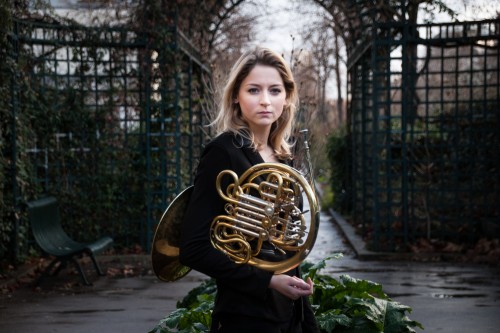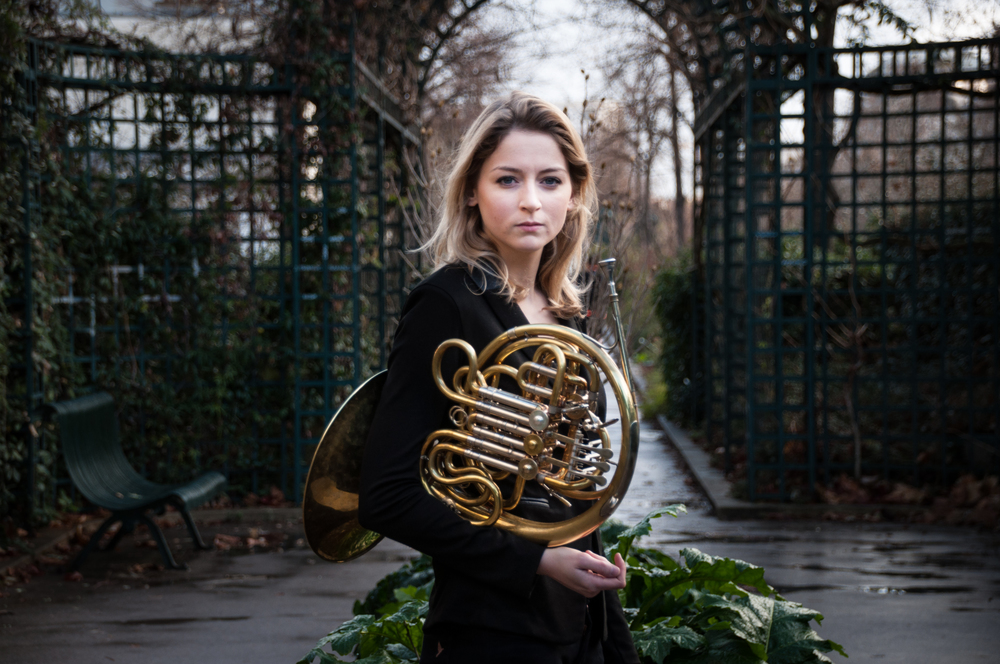 United Kingdom Bissill, Cherubini, Bernstein, Poulenc, Mozart: Katy Woolley (horn), Peter Adcock (piano), Dora Stoutzker Hall, Royal Welsh College of Music & Drama, Cardiff, 22.2.2019. (GPu)
United Kingdom Bissill, Cherubini, Bernstein, Poulenc, Mozart: Katy Woolley (horn), Peter Adcock (piano), Dora Stoutzker Hall, Royal Welsh College of Music & Drama, Cardiff, 22.2.2019. (GPu)

Richard Bissill – And So It Was
Cherubini – Horn Sonata No.2
Bernstein – Elegy for Mippy I
Poulenc – Elegie à la Memoire de Dennis Brain
Mozart – Rondo in E Flat, for horn. K.371
As one would expect from someone who was appointed Principal Horn of the RPO at the age of 22, Katy Woolley has an utterly sure technique. But there was no ostentatious display of her technical facility in this thoroughly enjoyable lunchtime concert. Indeed, there was an air of genuine modesty and a somewhat self-deprecating attitude in the way she presented herself on stage, constantly seeking confirmation from her excellent accompanist Peter Adcock: ‘Pianists have to be musically sophisticated, Horn players aren’t’, she said at one point. At another, introducing one of the pieces, she said disarmingly ‘I prepared several clever things to say about this piece, but I’ve forgotten all of them’. After playing the piece, she told us ‘I’ve remembered one of those clever things, but now I think about it, it isn’t really very clever’. What was ‘really clever’ was her well-planned programme and the skillful and richly expressive way in which she played it.
The two pieces of greatest substance were saved until the end of the programme – Poulenc’s Elegie à la Memoire de Dennis Brain and Mozart’s ‘Rondo in E flat for horn’ (K.371). Both – probably not by coincidence – were written ‘for’ (in two different senses of that word) a great horn player. Poulenc wrote his Elegie in September 1957, the day after hearing the news of Dennis Brain’s death in a road accident (at the age of just 36). Poulenc here makes the horn speak with a truly tragic eloquence and the piece has the feeling of something written whilst still coming to terms with loss – both dimensions of the music being very well captured by Woolley. In its single continuous movement, less than ten minutes in length, the piece incorporates something like the full sequence of reactions to a loss, the ‘process’ of grieving, as it were. After its unexpected opening (from this composer) with a twelve-tone row which expresses an initial unease, the music, growing somewhat aggressive – in the writing for both piano and horn (a passage played superbly by Adcock and Woolley) – is imbued with pain and shock, emotionally speaking, perhaps even that illogical kind of ‘’guilt’ one can feel on such occasions. As the music settled into a calmer sadness, Katy Woolley conjured some disturbing ‘sobs’ from her horn. This calmness (however troubled) was, in turn, shattered by some exclamations of anger. Gradually, however, a sense of acceptance emerged, notably in a lovely passage for stopped horn. Towards the end there were signs, at least, of hope – of the possibility of moving forward into a world without the person mourned, even if one has been changed by the loss. All of this was perfectly articulated by Woolley, very capably supported by Peter Adcock. As I listened, I couldn’t help but think of Milton’s great poem ‘Lycidas’, which traces a similar emotional trajectory. Oddly, I first read that great poem as an undergraduate soon after the vacation-time death of a fellow student and friend. Somewhat similarly Poulenc’s Elegie (though this wasn’t my first encounter with the piece) had a particular impact for me on this occasion, soon after the death of an old friend and former colleague.
Spirits were lifted by the closing work, Mozart’s ‘Rondo in E Flat for horn’. This was probably written for the horn player Joseph Leutgeb (as were the Horn Concertos and the Horn Quintet, K.407) – though some writers have suggested that the Rondo may have been written for the Viennese horn player Jacob Eisen. Leutgeb was a childhood friend of Mozart, who joined the Salzburg court orchestra c.1762/3. Born in Vienna (in 1732), Leutgeb returned to his native city, where Mozart renewed his friendship with him. Though he continued to play his horn, Leutgeb also worked as a cheese-monger, alongside his wife. Mozart dated this Rondo March 21, 1781. It was often thought to have been written as a stand-alone piece, but manuscript discoveries in the 1980s of related musical materials made it possible for Robert Levin to create a Horn Concerto No.0, by combining this Rondo with what is now known as K.370b. But the right and wrongs of this need not concern us here – since what we heard was purely the Rondo, in a reduction for horn and piano. And what a lovely piece it is! Though by no means the most complex or ambitious work by Mozart its characteristic emotional ambiguity and its delightful (and surely ‘delighted’) playfulness, in music full of a charm that is never merely charming and permeated by a kind of serious wit is enough to demonstrate the truth of what, for example, Aaron Copland wrote of Mozart: ‘Mozart tapped the source from which all music flows, expressing himself with a spontaneity and refinement and breathtaking rightness’. Woolley played with a fine sense of the Mozartean idiom. One could scarcely have wished, indeed, for a finer performance of the piece (though, to be hypercritical, there were moments when I found Peter Adcock’s piano accompaniment just a little too loud).
The other items in the programme were rather slighter than the works by Poulenc and Mozart, but not without interest. The recital began with Richard Bissill’s And So It Was. Bissill is himself an accomplished horn player (he was Principal Horn of the LPO from 1954-2009), as well as a composer, arranger and teacher. And So It Was, Woolley told us ‘was newish last year’. Given Bissill’s background, it comes as no surprise that this piece sounds so apt on the horn and sits comfortably for the player, as Woolley both told us and showed us. It is a persuasively charming piece in a relatively ‘popular’ idiom, with a slow introduction leading to some faster writing (where Woolley’s control and tone were excellent) and a short, slow conclusion. It makes no pretense to profundity but is attractive and enjoyable – at least when played as well as it was on this occasion. A fine opener!
The second of Cherubini’s two horn sonatas followed. Published in 1804, it was originally written for horn and strings – I think that what we heard was the arrangement for horn and piano by Barry Tuckwell. Though the piece was originally described as a ‘Concert Étude’, this short sonata is of genuine musical interest. It was written for, and dedicated to, a third major horn player (and composer) Frédéric Nicolas Duvernoy (1765-1838). Its single movement falls into two clearly demarcated sections, the first of which begins with a largo which incorporates an almost operatic recitative for the horn, before an energetic allegro (marked Allegro Moderato) follows, in which the horn is given a number of bright single notes, as well as a short cadenza which seems to have something of birdsong about it. Woolley’s playing, as one expected by now, was both energetic and agile, as well as utterly certain in intonation and perfectly phrased. While not an especially memorable piece (though the cadenza is striking), this Sonata both well-made and pleasingly melodic.
Bernstein’s ‘Elegy for Mippy I’ was written on the death of his brother Burton’s mongrel dog. A brief piece, less than three minutes long, it is part of a suite (of five pieces) Brass Music, commissioned by the Juilliard Music Foundation, and composed in 1948. The suite also contains ‘Elegy for Mippy II’ for solo trombone and ‘Waltz for Mippy’, written for tuba and piano. Rarely can a dog have had so many musical tributes (from the same composer!) on the occasion of its death. Woolley’s reading of the piece was emotionally well-judged, respectfully affectionate while resisting any temptation to go over the top. As so often with Bernstein, the idioms of jazz exist alongside the classical tradition in this piece. I have heard performances more responsive to the jazz dimensions of the piece than Ms Woolley’s was. I wonder how much she has listened to jazz masters of the French horn, such as Julius Watkins (especially), John Graas or the younger John Clark?
As suggested earlier, it was in the works by Poulenc and Mozart that this recital reached its musical climax and we heard the very best of Katy Woolley. This was a delightful concert, even if relatively brief as befits a lunchtime concert on a weekday, but full of beautiful horn playing. The delights were both musical (which matters most) and in terms of Katy Woolley’s interaction with her audience.
Glyn Pursglove
